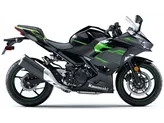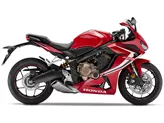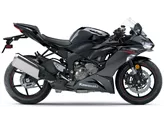Kawasaki Ninja 650 2017 vs. Kawasaki Ninja 400 2018

Kawasaki Ninja 650 2017

Kawasaki Ninja 400 2018
Visão geral - Kawasaki Ninja 650 2017 vs Kawasaki Ninja 400 2018
The Kawasaki Ninja 650 model year 2017 and the Kawasaki Ninja 400 model year 2018 are both supersport motorcycles produced by Kawasaki. While they have some similarities, they also have several differences in terms of their technical specifications and strengths.
Starting with the technical specifications, both motorcycles have an inline engine configuration and a telescopic front suspension with a diameter of 41mm. They also have a monoshock rear suspension with preload adjustment. In terms of engine displacement, the Ninja 650 has a larger displacement of 649cc compared to the Ninja 400's 399cc. The Ninja 650 also has a higher power output of 68.2 HP compared to the Ninja 400's 45 HP. Additionally, the Ninja 650 has a higher torque of 65.7 Nm compared to the Ninja 400's 38 Nm. The Ninja 650 has a higher compression ratio of 10.8 compared to the Ninja 400's 11.5. Both motorcycles have a steel frame and a tubular frame type. The Ninja 650 has a rake of 65.5 degrees and a trail of 100mm, while the Ninja 400 has a rake of 63 degrees and a trail of 93mm. In terms of braking, the Ninja 650 has dual disc brakes with a diameter of 300mm, while the Ninja 400 has a single disc brake with a diameter of 310mm. Both motorcycles are equipped with ABS as a standard feature.

Kawasaki Ninja 650 2017
Moving on to their strengths, the Ninja 650 2017 has a transparent chassis for sport riding, providing a playful and enjoyable handling experience. It also has excellent brakes and an elegant appearance inspired by the ZX-10R. The engine of the Ninja 650 is known for its durability.
On the other hand, the Ninja 400 2018 has a chassis that is suitable for sport riding, with a reduced weight and effortless handling to match. The engine of the Ninja 400 delivers smooth power delivery. The relaxed seating position of the Ninja 400 increases confidence, and it is equipped with LED headlights.

Kawasaki Ninja 400 2018
However, both motorcycles also have their weaknesses. The Ninja 650 2017 has a lack of sound from the stock exhaust and slight vibrations from the engine. The Ninja 400 2018 has non-adjustable brake and clutch levers and high wind noise with the stock windscreen for riders over 180cm tall.
In conclusion, the Kawasaki Ninja 650 2017 and the Kawasaki Ninja 400 2018 are both capable supersport motorcycles with their own strengths and weaknesses. The Ninja 650 offers a more powerful engine and an elegant appearance, while the Ninja 400 provides a lightweight and effortless handling experience. Ultimately, the choice between the two will depend on the rider's preferences and intended use.
Especificações técnicas Kawasaki Ninja 650 2017 em comparação com Kawasaki Ninja 400 2018
Prós e contras em comparação
Prós e contras em comparação
Kawasaki Ninja 650 2017

A Ninja 650 é um selo firme da sua antecessora (Er-6f). O motor dominou bem a barreira do Euro 4 e oferece 68 cv muito úteis, o chassis é simplesmente fantástico para esta classe e a redução de peso de 18(!) quilos em comparação com a ER-6f justifica acenos de cabeça reverentes.
Kawasaki Ninja 400 2018

Em resumo, a Ninja 400 pode ser descrita como a entrada perfeita no mundo das superdesportivas. Não é possível obter mais potência com a A2, o aspeto sugere muito mais potência, o veículo é divertido de conduzir, é indulgente em todos os aspectos e ainda permite um estilo de condução verdadeiramente desportivo. Aqueles que tinham preocupações legítimas sobre a falta de potência nas várias máquinas de 250 cúbicos agora não têm mais desculpas. Ninja 400, é bom ter-te connosco!
Comparação de preços Preço médio de mercado Kawasaki Ninja 650 vs Kawasaki Ninja 400
There are a few key differences between a Kawasaki Ninja 650 2017 and a Kawasaki Ninja 400 2018. In terms of price, the actual average price of a Kawasaki Ninja 650 2017 is about 12% higher. A Kawasaki Ninja 650 2017 experiences a loss of 480 EUR in one year and 620 EUR in two years of ownership. This is offset by a loss of 160 EUR and 230 EUR for a Kawasaki Ninja 400 2018. Compared to Kawasaki Ninja 400 2018 there are less Kawasaki Ninja 650 2017 bikes available on the 1000PS.de Marketplace, specifically 7 compared to 10. It takes less time to sell a Kawasaki Ninja 650 with 96 days compared to 105 days for a Kawasaki Ninja 400. Since model year 2017 1000PS.de editors have written 20 reviews for the Kawasaki Ninja 650 and 9 reviews for the Kawasaki Ninja 400 since model year 2018. The first review for the Kawasaki Ninja 650 was published on 04/10/2016 and now has more than 79 600 views. This compares to more than 44 300 views for the first review on Kawasaki Ninja 400 published on 22/11/2017.
















